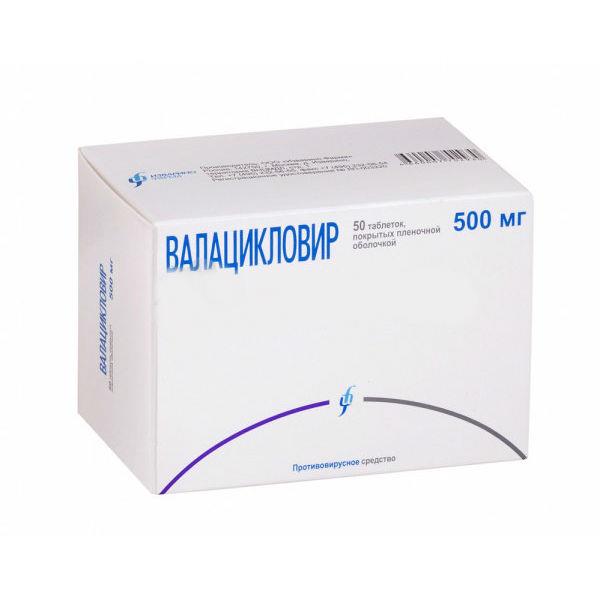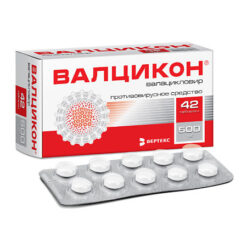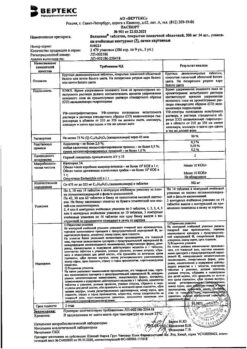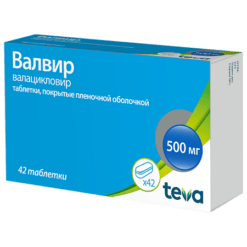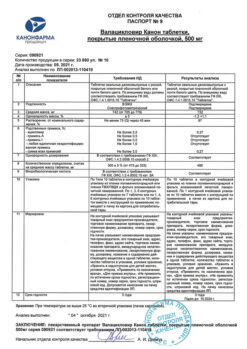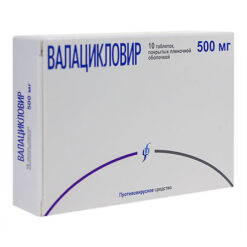No products in the cart.
Description
Antiviral agent.
Pharmacodynamics
Valacyclovir is an antiviral agent, it is L-valine ester of acyclovir. Acyclovir is an analog of the purine nucleoside (guanine). In humans, valacyclovir is rapidly and almost completely converted to acyclovir and L-valine, presumably by the enzyme valacyclovirhydrolase.
Acyclovir in vitro has specific inhibitory activity against herpes simplex virus (HPV) types 1, 2 (Herpes simplex 1, 2 types), varicella zoster virus (VZV), cytomegalovirus (CMV), Epstein-Barr virus (EBV) and human herpes virus type 6. Acyclovir inhibits the synthesis of viral DNA immediately after phosphorylation and transformation into the active form acyclovirtriphosphate.
The first stage of phosphorylation occurs with the participation of virus-specific enzymes. For HPV, VZV and VEB viruses this enzyme is viral thymidine kinase, which is present only in virus-infected cells. Partial selectivity of phosphorylation is retained in cytomegalovirus and is mediated through the product of the phosphotransferase gene UL97. Activation of acyclovir by a specific viral enzyme largely explains its selectivity.
The process of acyclovir phosphorylation (conversion from mono- to triphosphate) is completed by cellular kinases. Acyclovir triphosphate competitively inhibits viral DNA polymerase and, being a nucleoside analog, is incorporated into viral DNA, which leads to obligate breaking of the chain, cessation of DNA synthesis and, consequently, to blocking of virus replication.
In immunocompromised patients, valacyclovir-unresponsive HPV and VZV are extremely rare, but can sometimes be found in patients with severe immune disorders, such as those with bone marrow transplants, those receiving chemotherapy for malignancies and those infected with HIV.
Aciclovir resistance is caused by a thymidine kinase deficiency in the virus, which leads to excessive spread of the virus in the host. Sometimes the decrease in sensitivity to acyclovir is due to the emergence of virus strains with a disrupted structure of viral thymidine kinase or DNA polymerase. The virulence of these varieties of the virus is similar to that of its wild strain.
Indications
Indications
Adults and teenagers aged 12 to 18 years
treatment of skin and mucous membrane infections caused by HSV, including newly diagnosed and recurrent genital herpes (Herpes genitalis), as well as labial herpes (Herpes labialis);
prevention (suppression) of recurrent infections of the skin and mucous membranes caused by HSV, including genital herpes, including in adults with immunodeficiency;
prevention of infections caused by cytomegalovirus (CMV) and diseases after solid organ transplantation.
Adults
treatment of herpes zoster (Herpes zoster) and ophthalmic herpes zoster.
Pharmacological effect
Pharmacological effect
Antiviral agent.
Pharmacodynamics
Valaciclovir is an antiviral agent, an L-valine ester of acyclovir. Acyclovir is an analogue of purine nucleoside (guanine). In the human body, valacyclovir is quickly and almost completely converted into acyclovir and L-valine, presumably under the influence of the enzyme valacyclovir hydrolase.
Acyclovir in vitro has specific inhibitory activity against herpes simplex viruses (HSV) types 1, 2 (Herpes simplex types 1, 2), varicella zoster virus (VZV – varicella zoster virus), cytomegalovirus (CMV), Epstein-Barr virus (EBV) and human herpes type 6. Acyclovir inhibits viral DNA synthesis immediately after phosphorylation and conversion to the active form of acyclovir triphosphate.
The first stage of phosphorylation occurs with the participation of virus-specific enzymes. For the HSV, VZV and EBV viruses, this enzyme is viral thymidine kinase, which is present only in cells affected by the virus. Partial phosphorylation selectivity is conserved in cytomegalovirus and is mediated through the UL97 phosphotransferase gene product. Activation of acyclovir by a specific viral enzyme largely explains its selectivity.
The process of phosphorylation of acyclovir (conversion from mono-to triphosphate) is completed by cellular kinases. Acyclovir triphosphate competitively inhibits viral DNA polymerase and, being a nucleoside analogue, is incorporated into viral DNA, which leads to obligate chain breakage, cessation of DNA synthesis and, consequently, blocking viral replication.
In patients with preserved immunity, HSV and VZV viruses with reduced sensitivity to valacyclovir are extremely rare, but can sometimes be found in patients with severe immune disorders, for example, with a bone marrow transplant, in those receiving chemotherapy for malignant neoplasms and in HIV-infected patients.
Resistance to acyclovir is caused by a deficiency of the virus’ thymidine kinase, which leads to excessive spread of the virus in the host. Sometimes a decrease in sensitivity to acyclovir is due to the emergence of virus strains with a violation of the structure of the viral thymidine kinase or DNA polymerase. The virulence of these variants of the virus resembles that of the wild strain.
Special instructions
Special instructions
Hydration
In patients at risk of dehydration, especially elderly patients, adequate fluid replacement must be ensured during treatment.
Use in patients with renal failure and in elderly patients
Since acyclovir is excreted by the kidneys, the dose of Valacyclovir should be reduced depending on the degree of renal impairment. Patients with renal impairment and elderly patients are at increased risk of developing neurological complications and should be closely monitored. As a rule, these reactions are largely reversible.
Use of high doses of valacyclovir for liver dysfunction and after liver transplantation
There is no data on the use of valacyclovir in high doses (4000 mg per day or higher) in patients with liver disease, so high doses of valacyclovir should be administered to such patients with caution. No specific studies have been conducted to study the effect of valacyclovir in liver transplantation. However, it has been found that prophylactic administration of high doses of acyclovir reduces the manifestation of CMV infection and disease.
Use for genital herpes
Patients should abstain from sexual intercourse if symptoms are present, even if antiviral treatment is started. Suppressive therapy with valacyclovir reduces the risk of transmission of genital herpes, but does not eliminate the risk of infection and does not lead to a complete cure. Therapy with Valacyclovir is recommended in combination with reliable means of barrier contraception.
Use for CMV infections
The use of valacyclovir in high doses for the prevention of CMV infection leads to a more frequent occurrence of side effects, including CNS disorders, than when used in lower doses for other indications. Careful monitoring of renal function in such patients is necessary, with dose adjustments if necessary.
Impact on the ability to drive vehicles and machinery
There is no data on the effect of valacyclovir, used in therapeutic doses, on the ability to drive vehicles and machines. However, when assessing the patient’s ability to drive a car or move machinery, it must be taken into account that side effects from the central nervous system may occur, so caution should be exercised.
Active ingredient
Active ingredient
Valaciclovir
Composition
Composition
1 film-coated tablet contains:
Tablet core composition:
Active substance:
valacyclovir hydrochloride – 556.2 mg (in terms of valacyclovir 500.0 mg).
Excipients:
microcrystalline cellulose – 84.3 mg,
hypromellose – 42.0 mg,
crospovidone – 7.0 mg,
magnesium stearate – 7.0 mg,
colloidal silicon dioxide – 3.5 mg.
Tablet shell composition:
Opadry II white (33G28435) – 25.0 mg (hypromellose – 40.0%, titanium dioxide – 25.0%, macrogol 3350 – 8.0%, lactose monohydrate – 21.0%, triacetin – 6.0%).
Pregnancy
Pregnancy
Pregnancy There are limited data on the use of valacyclovir and little data on the use of acyclovir (the active metabolite of valacyclovir) during pregnancy in women.
Reported data on pregnancy outcomes in women taking valacyclovir or acyclovir did not show an increase in the number of birth defects in their children compared with the general population. Valaciclovir is used only in cases where the potential benefit to the mother outweighs the possible risk to the fetus. Breastfeeding period Acyclovir, the main metabolite of valacyclovir, is excreted in breast milk. After administration of valacyclovir at a dose of 500 mg orally, the Cmax of acyclovir in breast milk was 0.5-2.3 times (on average 1.4 times) higher than the corresponding concentrations of acyclovir in maternal blood plasma. The mean concentration of acyclovir in breast milk was 2.24 μg/ml (9.95 μmol/L).
When the mother takes valacyclovir at a dose of 500 mg
The child is exposed to the same effects of acyclovir 2 times a day as when taken orally at a dose of about 0.61 mg/kg/day. The half-life of acyclovir from breast milk is the same as from blood plasma.
Valacyclovir unchanged was not detected in maternal plasma, breast milk or infant urine.
The drug Valacyclovir should be prescribed with caution to women during breastfeeding.
Contraindications
Contraindications
Hypersensitivity to valacyclovir, acyclovir and any other component included in the drug;
HIV infection with a CD4+ lymphocyte count of less than 100 in 1 μl;
Children under 12 years of age;
Children under 18 years of age in the treatment of herpes zoster and ophthalmic herpes zoster.
With caution
Renal failure, old age, patients at risk of dehydration, concomitant use of nephrotoxic drugs, pregnancy, lactation, clinically pronounced forms of HIV infection in patients.
Side Effects
Side Effects
Side effect frequency categories: very common (>1/10), common (>1/100 to 1/1000 to 1/10000 to <1/1000), very rare (<1/10000).
From the gastrointestinal tract: often – nausea; rarely – abdominal discomfort, vomiting, diarrhea.
From the blood system and hematopoietic organs: very rarely – leukopenia (mainly observed in patients with reduced immunity), thrombocytopenia.
From the immune system: rarely – anaphylaxis.
From the nervous system and psyche: often – headache; rarely – dizziness, confusion, hallucinations, depression of consciousness; very rarely – tremor, agitation, ataxia, dysarthria, psychotic symptoms, convulsions, encephalopathy, coma.
The symptoms listed above are mostly reversible and are usually observed in patients with renal failure or other predisposing conditions. In organ transplant patients receiving valacyclovir in high doses (8 g/day) for the prevention of CMV infection, neurological reactions develop more often than when taking lower doses.
From the respiratory system: infrequently – shortness of breath.
From the liver and biliary tract: very rarely – reversible disturbances in liver function tests, which are sometimes regarded as a manifestation of hepatitis.
From the skin and subcutaneous fat: infrequently – rashes, including manifestations of photosensitivity; rarely – itching; very rarely – urticaria, angioedema.
From the urinary system: infrequently – hematuria (often associated with other renal disorders); rarely – renal dysfunction; very rarely – acute renal failure, renal colic.
Precipitation of acyclovir crystals in the lumen of the renal tubules was also noted. During treatment, adequate drinking regimen should be maintained.
In patients with severe immunocompromise, especially in adult patients with advanced HIV infection, receiving high doses of valacyclovir
(8 g/day daily) for a long time, cases of renal failure, microangiopathic hemolytic anemia and thrombocytopenia (sometimes in combination) have been observed. Similar complications were noted in patients with the same underlying and/or concomitant diseases, but who did not receive valacyclovir.
Interaction
Interaction
Clinically significant interactions have not been established.
Acyclovir is excreted by the kidneys, mainly unchanged, through active renal secretion. The combined use of drugs with this elimination mechanism may lead to an increase in the concentration of acyclovir in the blood plasma.
After administration of the drug Valaciclovir at a dose of 1000 mg, cimetidine and probenecid, which are eliminated in the same way as valacyclovir, increase the AUC of acyclovir and thus reduce its renal clearance. However, due to the wide therapeutic index of acyclovir, dose adjustment of Valaciclovir is not required in this case.
Caution must be exercised in the case of simultaneous use of the drug Valaciclovir in higher doses (4000 mg per day and above) and drugs that compete with acyclovir for the elimination route, since there is a potential threat of increasing the plasma concentration of one or both drugs or their metabolites. An increase in the AUC of acyclovir and the inactive metabolite mycophenolate mofetil (an immunosuppressant used after organ transplantation) was observed when these drugs were taken concomitantly.
Concomitant use of valacyclovir with nephrotoxic drugs, including aminoglycosides, organic platinum compounds, iodinated contrast agents, methotrexate, pentamidine, foscarnet, cyclosporine and tacrolimus, should be used with caution, especially in patients with impaired renal function, and requires regular monitoring of renal function.
Overdose
Overdose
Symptoms
An overdose of valacyclovir may cause acute renal failure and the development of neurological symptoms, including confusion, hallucinations, agitation, depression of consciousness and coma, as well as nausea and vomiting. To prevent overdose, the dosage regimen should be followed. Many cases of overdose have been associated with the use of the drug in the treatment of patients with impaired renal function and elderly patients due to non-compliance with the dosage regimen (repeatedly receiving doses of valacyclovir exceeding the recommended ones).
Treatment
Patients should be closely monitored for timely diagnosis of toxic manifestations. Hemodialysis significantly accelerates the elimination of acyclovir from blood plasma and can be considered the optimal method of treatment in case of overdose.
Storage conditions
Storage conditions
In a place protected from light at a temperature not exceeding 25 ° C.
Keep out of the reach of children.
Shelf life
Shelf life
2 years.
Do not use after expiration date.
Manufacturer
Manufacturer
Izvarino Pharma, Russia
Additional information
| Shelf life | 2 years. Do not use after the expiration date. |
|---|---|
| Conditions of storage | In the dark place at a temperature not exceeding 25 °С. Store out of the reach of children. |
| Manufacturer | Izvarino Pharma, Russia |
| Medication form | pills |
| Brand | Izvarino Pharma |
Other forms…
Related products
Buy Valacyclovir, 500 mg 50 pcs. with delivery to USA, UK, Europe and over 120 other countries.

